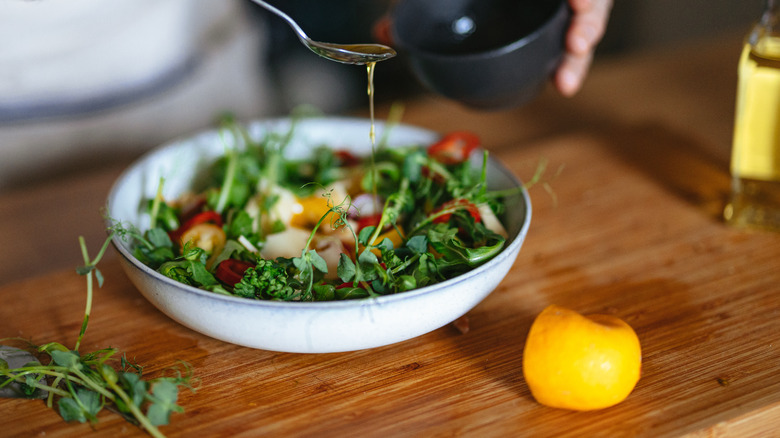Dried Lemon Peels Are The Simple Way To Elevate Any Salad Dressing
While we tend to associate citrus fruits with their tart, acidic juices, the peels are where the flavor actually concentrates. They may not be good to eat raw, but lemon peels contain a wealth of essential oils that deliver an intense lemony taste. Consequently, recipes like lemon pie, lemon rice, and even lemon-infused cocktails call for lemon juice and/or lemon zest. Lemon zest is a great flavoring agent, but its short shelf life is somewhat limiting. Dried lemon peels are the long-lasting, concentrated lemon flavor that can elevate plenty — including salad dressing.
Drying lemon peels is a quick and easy process that locks in all the citric notes to give any salad dressing recipe a burst of flavor. You can add the peels whole or grind them into a powder and sprinkle them into a salad dressing recipe. They'd taste especially delicious with an earthy olive oil-based dressing, like a vinaigrette — with a sweet complement from honey or balsamic vinegar, or a spicy pairing like spicy mustard, red pepper flakes, or crushed black pepper.
Moreover, you could easily put a few dried peels at the bottom of a mason jar, top them with the liquid and aromatic ingredients, and shake to combine. You could also make a spice mixture with ground lemon peels, dried herbs, and dried garlic granules to stir into a mayo, yogurt, or cream-based salad dressing like ranch.
Preparing lemon peels for your salad dressing
Dehydrated citrus peels have significantly longer shelf lives than fresh oily zest. Plus, they require no fancy equipment. All you need to do is strip the lemon of its peel, creating similar-sized scraps. Then, you'll place them on a baking sheet to dry out in an oven at a low temperature for half an hour; Oven temperatures range from 170 to 200 degrees Fahrenheit. You don't even have to use an oven to dry citrus peels, instead can leave them to dry on your countertop for two to three days.
It's important to only use the colorful peels, avoiding the white pith as you remove them with a paring knife or potato peeler. You can use the lemon peels to infuse olive or avocado oil so you'll have a lemon-flavored oil to elevate your dressing. You can also add the peels directly to the dressing or grind them up with other seasonings. You'll need far fewer dried peels than zest; recipes recommend a teaspoon of powdered zest for every two teaspoons of fresh zest.
You can dry any citrus peel you have in mind, from oranges to grapefruit to yuzu. You can also blend various citrus peels into a single salad dressing for more depth of flavor. Another idea is to use dried lemon peel with sweet orange juice so you get two different citrus profiles using different methods.

